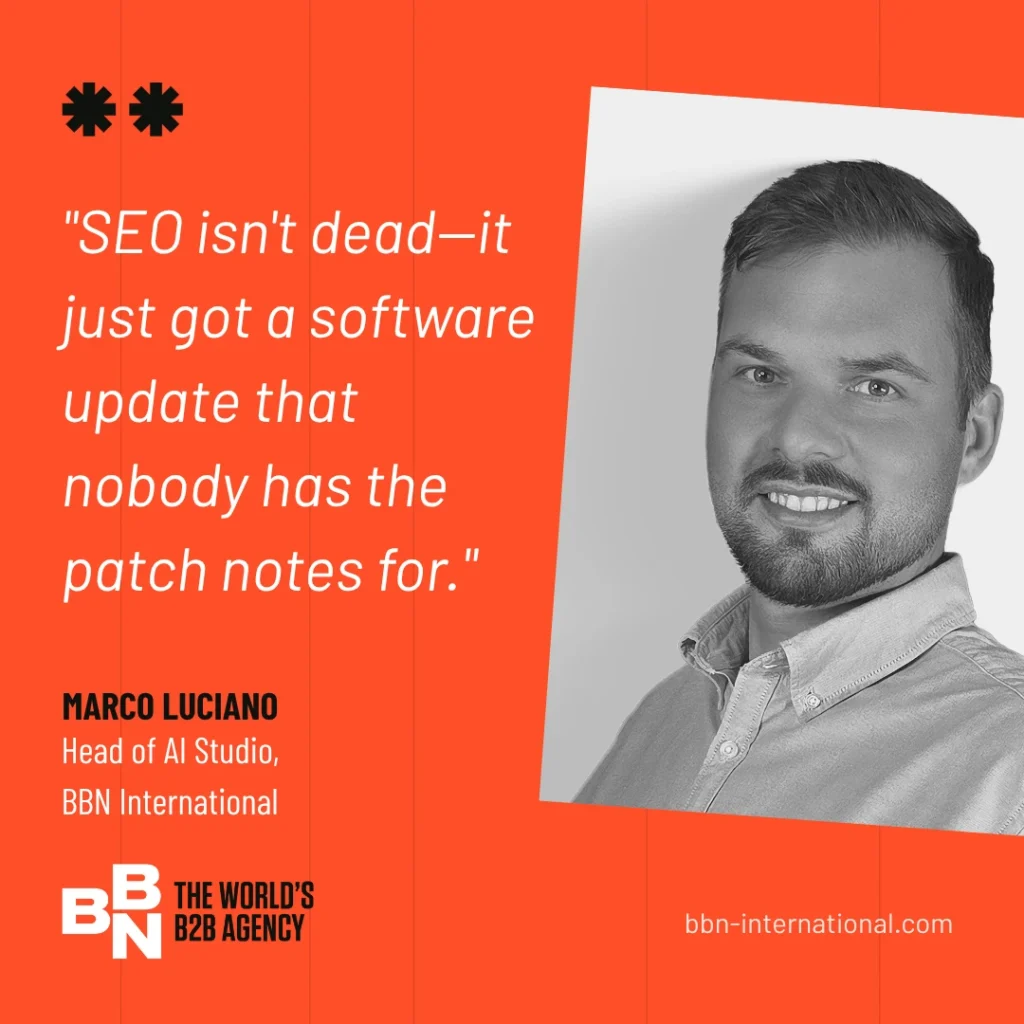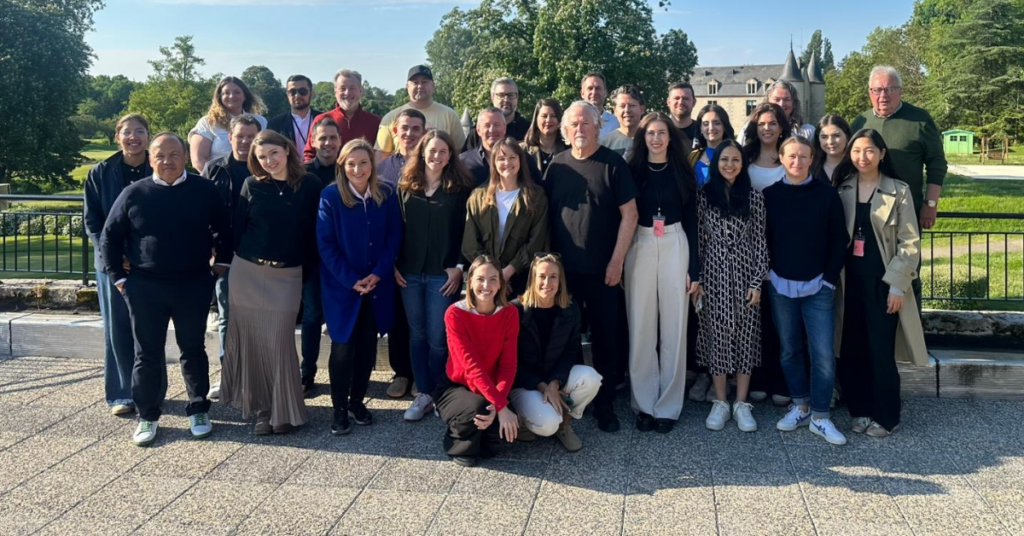Why Your Current SEO Strategy Needs an AI Reality Check
Picture this: Your prospect opens their favorite AI chat, asks about industrial automation solutions, next-generation software, or a specific feature on their agricultural machine, and gets a detailed answer—without ever visiting your carefully optimized website. Sound familiar?
The numbers tell the story: Over 15 million adults in the U.S. now use generative AI as their primary search method, with projections suggesting this could rise to over 36 million in the next four years. In 2024, ChatGPT alone handled 37.5 million search-like queries daily, with user sessions lasting 8-13 minutes—far longer than traditional search interactions.
But here’s what our partner agency STOICA mentioned in their recent article: 72% of B2B buyers now encounter AI Overviews during their research process, and 90% of them verify information by clicking on cited sources. This means your content needs to be both AI-discoverable and citation-worthy.
Search behavior has changed already, and the only question is whether your B2B marketing can adapt fast enough before falling behind. Welcome to the age of GEO: Generative Engine Optimization.
What Exactly Is GEO?
Think of traditional SEO as optimizing for Google’s algorithms. GEO is optimizing for AI’s brain.
The new acronym soup looks like this:
- SEO (Search Engine Optimization): Will you rank in top spots on Google/Bing?
- AIO (AI Optimization): Will AI learn about your offering?
- AEO (Answer Engine Optimization): Will AI use your offering in highlights/responses?
- GEO (Generative Experience Optimization): Will AI recommend your offering?
- SXO (Search Experience Optimization): Will users stick around and take action?
ChatGPT holds 80.1% of AI search traffic, while traditional search engines are experiencing decline. A significant portion of queries to AI chatbots (70%) don’t fit traditional search intent categories—users are seeking information in entirely new ways.
AI agents are becoming a new user group, browsing the web on behalf of B2B decision makers. Your content needs to feed these digital scouts effectively.
The Four Pillars of AI-Age Optimization
1. Research: Think Conversations, Not Keywords
Traditional keyword research focused on search volume and competition. AI-age research thinks in conversational queries and semantic clouds.
Instead of targeting “industrial automation software,” consider how a plant manager actually asks: “What’s the best way to automate our packaging line without disrupting current production?”
Modern research tools like Screaming Frog now offer semantic similarity analysis and cluster visualizations. Tools like Mentions.so, PeecAI, and WriteSonic can dig deeper into conversational patterns.
The key shift: Content should be guided by specific user problems, not just keywords. Entity-based optimization—focusing on specific concepts rather than just keywords—is becoming crucial for AI-driven results.
2. Structure: Make AI-Friendly Content Chunks
Well-structured topics give AI (and humans) manageable chunks to work with. Think of your content as building blocks that AI can easily reference and recombine.
Practical structure tips from STOICA, one of our partner agencies:
- Use conversational headers that mirror how prospects actually ask questions
- Add key takeaway boxes that AI can quickly reference
- Break complex topics into digestible sections
- Create FAQ-style content that directly answers common questions
- Interlink related topics to create comprehensive topic clouds
Remember: AI doesn’t just scrape your homepage. It processes your entire content ecosystem to understand your expertise. The trend toward multimodal optimization means AI now processes text, images, videos, and audio—so structure all your media assets accordingly.
3. Authority: Prove You’re Better Than “Somewhere”
AI models train on data found “somewhere” on the internet. Your job is proving you’re better than that generic somewhere. Users now ask “Do I trust this brand?” before “Does this answer my question?” This means authority building has become paramount.
The HEEAT framework helps check your content:
- Helpful: Does it solve real problems?
- Expertise: Do you demonstrate deep knowledge?
- Experience: Can you share firsthand insights?
- Authority: Are you recognized in your field?
- Trustworthiness: Do you cite sources and provide proof?
Build proprietary frameworks instead of chasing generic keywords. Create in-depth frameworks around specific topics that establish your authority in the industry. This positions your content as a go-to resource for AI systems.
LinkedIn, Reddit, Wikipedia, and Quora heavily influence AI training. Finding niche B2B conversations and contributing helpful (not spammy) content creates valuable AI training inference.
4. Schema: Structure Data for Machine Understanding
Schema markup isn’t just for Google anymore—it’s essential for AI optimization. Recent developments show a shift toward advanced knowledge graph development that supports AI discovery systems.
Essential schema types for B2B content:
- Product schema for your solutions
- Organization schema for company information
- FAQ schema for common questions
- How-To schema for process explanations
Pro tip: Add an llms.txt file to your website repository. This markdown file might act as “first-hand information” to AI systems in the future.
Use Google’s Rich Results Test to validate your structured data implementation.
Busting SEO Myths for the AI Age
Our BBN partners in Japan and India/US recently hosted a webinar that busted several persistent SEO myths for the AI age. Here are the key revelations:
Myth 1: “Traffic is still the ultimate metric.”
Reality: AI citations and brand mentions in AI responses matter more than raw traffic numbers.
Myth 2: “Keywords are dead.”
Reality: Keywords evolved into conversational intent patterns. The focus shifted from keyword density to semantic relevance.
Myth 3: “Mobile-first is enough.”
Reality: Mobile users engage more deeply with AI Overviews, requiring enhanced mobile optimization beyond basic responsiveness.
Myth 4: “Content quantity beats quality”
Reality: AI systems prioritize authoritative, well-structured content over volume. One comprehensive framework beats ten shallow articles.
The Content Marketing Revolution
Here’s the uncomfortable truth: Content marketing is more relevant than ever, but traditional success metrics are breaking down.
The new reality:
- Your public, ungated information is what AI learns from
- Traffic isn’t the obvious success indicator anymore
- You need to combine first-party data with AI behavior analysis tools
- Reporting becomes significantly more complicated
Go ungated or go home. If your best insights are locked behind forms, AI can’t learn about your expertise. This doesn’t mean giving away everything—it means strategically sharing knowledge that positions you as the authority AI should reference.
Avoiding the Tool Chaos
Every SEO tool now claims “AI features.” Google adds AI to its suite but limits what you can learn. Niche tools focus on specific GEO tasks.
Chasing shiny features that don’t add B2B value. Instead, you should focus on tools with proven B2B applications. Screaming Frog’s semantic analysis features provide solid foundation work. Google Search Central offers reliable structured data guidance.
But remember—SEO is more think-work now. Tools support strategy; they don’t replace strategic thinking.

Your GEO Action Plan
- Assess your current content for structure, clarity, and topical authority.
- Compare that to user intents across their messy B2B journey. Check Google’s Messy Middle Model for more info.
- Create interlinked topic clouds (including longtail variations) matched with authority signals and schema ideas.
- Adapt content for conversations—turn blog articles into How-To guides based on real industry discussions.
- Refine content with alternative questions and AI feedback.
- Track performance with enhanced KPIs that go beyond traditional traffic metrics.
The Path Forward: B2B Without Borders
The transition from SEO to GEO isn’t optional—it’s inevitable. B2B marketers who adapt now will own the conversations AI has about their industries. This is B2B without borders: Your expertise and solutions can now influence clients and digital agents across continents, transcending the boundaries of traditional search. The next generation of search knows no borders—neither should your marketing.
Current trends point toward smarter search algorithms that differentiate between AI-generated and human-generated content, emphasizing originality and depth.
Need structured support for this transition?
- BBN AI Academy delivers hands-on training in all things content marketing, so your team masters AI optimization while maintaining strategic focus.
- BBN AI Space provides a secure environment including a content engine that generates drafts with highest consistency and traceability of all steps – much more professional than your typical customGPT and without risking sensitive data exposure.
Learn more about the BBN AI Academy and BBN AI Space here.
About BBN International
BBN is the world’s B2B agency, spanning five continents with agencies in 31 countries. Through its unique “B2B without borders” approach, BBN combines local expertise with global reach, helping clients accelerate growth and master marketing transformation. Our distributed agency model means you have access to the best B2B minds, wherever you are in the world. Learn more at bbn-international.com.
SHARE ARTICLE



